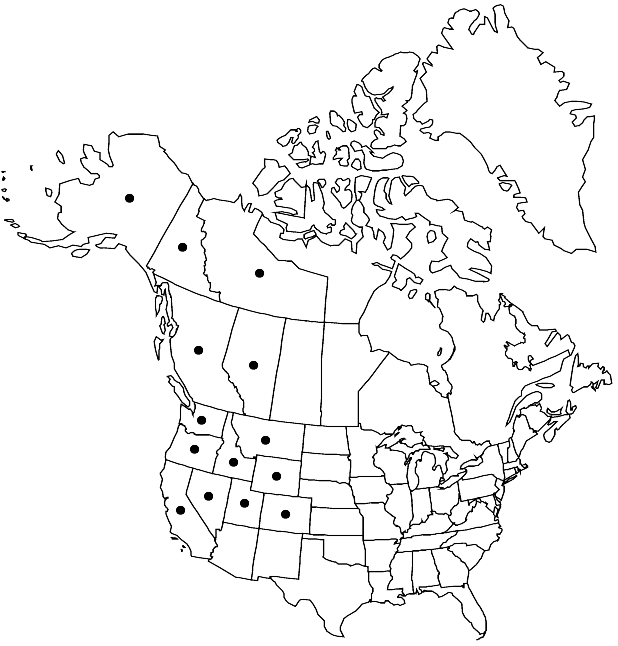Draba lonchocarpa
Mem. New York Bot. Gard. 1: 181. 1900.
Perennials; (cespitose, sometimes forming mats); caudex branched (covered with persistent leaf-bases); often scapose. Stems unbranched, (0.1–) 0.3–1.1 dm, glabrous throughout or pubescent proximally or throughout, trichomes minutely stalked, 8–12-rayed, (non-crisped), 0.08–0.3 mm. Basal leaves rosulate; shortly petiolate; petiole (obsolete), margin ciliate proximally, (trichomes soft, simple, 2-rayed, 0.2–0.6 mm); blade oblanceolate to obovate, (0.2–) 0.3–1.5 cm × 1–3 (–5) mm, margins entire, surfaces pubescent abaxially with short-stalked, stellate, 8–12-rayed, (non-crisped) trichomes, 0.15–0.4 mm, (midvein obscure), adaxially glabrous basally or with simple and long-stalked, branched trichomes. Cauline leaves 0 or 1 (–4); sessile; blade ovate or oblong, margins entire, surfaces pubescent as basal. Racemes 3–9-flowered, usually ebracteate, rarely proximalmost 1 (–4) flowers bracteate, elongated in fruit; rachis often slightly flexuous (in fruit), glabrous or pubescent as stem. Fruiting pedicels ascending, usually straight, rarely curved upward, 2–9 (–15) mm, glabrous or pubescent as stem. Flowers: sepals ovate, 1.5–2 mm, pubescent, (trichomes simple and short-stalked, 2–5-rayed); petals white, oblanceolate, 2–3.5 × 1–1.5 mm; anthers ovate, 0.2–0.3 mm. Fruits linear to narrowly lanceolate or narrowly oblong, slightly twisted or plane, flattened, 6–15 (–18) × 1–2 (–3) mm; valves glabrous or sparsely puberulent, trichomes simple and minutely stalked, 2-rayed, 0.1–0.2 mm; ovules 16–24 (–28) per ovary; style (0.05–) 0.1–0.25 (–0.35) mm. Seeds ovoid, 0.7–1 × 0.5–0.6 mm. 2n = 16.
Phenology: Flowering Jun–Jul.
Habitat: Rocky outcrops and ridges, loose talus, tundra
Elevation: (300-)2800-4000 m
Distribution

Alta., B.C., N.W.T., Yukon, Alaska, Calif., Colo., Idaho, Mont., Nev., Oreg., Utah, Wash., Wyo., e Asia (Russian Far East), e Asia (Siberia)
Discussion
Draba lonchocarpa is a highly variable species within which O. E. Schulz (1927), G. A. Mulligan (1974), and R. C. Rollins (1993) recognized three to five varieties. By contrast, C. L. Hitchcock (1941) united it with D. nivalis and recognized six varieties (see 68. D. nivalis for differences). Some of the infraspecific taxa of D. lonchocarpa are based on trivial characteristics and are listed in the synonymy above without further comment. The most problematic are briefly discussed below.
Authors recognizing var. vestita claim that it differs from var. lonchocarpa by having pubescent (versus glabrous) stems and pedicels, 1- or 2-leaved (versus 0 or 1-leaved) scapes, and fruits appressed (versus not appressed) to the rachises. These characteristics do not appear to be strongly correlated. A case in point is the holotype sheet of var. semitonsa, which includes plants with puberulent or glabrous fruits, as well as with pubescent and glabrous stems that are 0–4-leaved. Leafless and densely pubescent scapes are found in Trelease 3913 (MO), whereas completely glabrous, 0–2-leaved stems, and fully appressed fruits are found in Calder 5617a (DAO). Other exceptions can be cited, though the vast majority of the plants examined have leafless, glabrous scapes.
An examination of the type collections of var. thompsonii, Thompson 9512 (holotype, UC; isotypes, DS, GH, MO, NY, RSA, US), clearly shows that the taxon usually has oblong to lanceolate fruits 2–3.2 mm wide, as opposed to linear fruits less than 2 mm wide in var. lonchocarpa. Indeed, a casual observation would immediately justify the recognition of var. thompsonii. Both fruit types can be found in plants of the same population (e.g., the RSA isotype) or even on the same plant (e.g., Thompson 10816, MO). Furthermore, fruits to 2.5 mm wide occur sporadically in various parts of the species range. For these reasons, and in the absence of a comprehensive study of the species, we choose to not recognize var. thompsonii at present.
Draba lonchocarpa is found at elevations of 300–1200 m in Alaska.
Selected References
None.
Lower Taxa
"elongated" is not a number."not" is not a number. "elongated" is not a number."thick" is not a number.